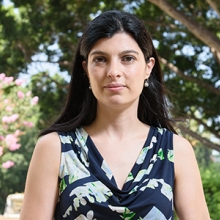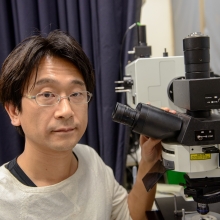Dr. Mark Shusterman
Cracking the properties of prime numbers
New scientists

Prime numbers—integers that can only be divisible by themselves and “1”—are governed by a handful of rules that mathematicians have known since antiquity. However, while these rules are easily inferred, they are considerably more difficult to prove.
Dr. Mark Shusterman, who will join the Department of Mathematics, is working to prove one of the oldest and most famous unsolved problems in mathematics: the twin prime conjecture. This conjecture states that there are an infinite number of prime number pairs that differ by 2 (for example: 11 and 13, or 17 and 19). While mathematicians are fairly certain that this is true, it has never been proven.
Currently in his postdoctoral fellowship at Harvard University, Dr. Shusterman is using a roundabout approach to prove this conjecture. Instead of looking directly at prime numbers, he is studying polynomials—an analogous number system composed of simple variables and coefficients that, like the prime number system, comes in pairs and does not have any divisors. On the flip side of the same coin, polynomials are defined over a finite field—meaning that it is a number system that does not continue forever on the number line the way integers do, but loops back on itself.
Additionally, prime numbers are governed by a number of constraints. For example, prime numbers must be odd, otherwise they can be divisible by 2. Therefore, a prime number cannot end in 0, 2, 4, 6, or 8. Similarly, the sum of the digits of a prime number cannot be divisible by 3, because then the number itself is divisible by 3.
Since the various constraints that exist for the digits of prime numbers can also be applied to the coefficients of polynomials, Dr. Shusterman is formulating polynomial equations that conform to the twin prime parameters, and plotting them on a graph. This approach has a singular advantage: when graphically mapped out, these equations form geometric shapes, rather than the one-dimensional dots produced by individual prime numbers.
“These geometric shapes are versatile algebraic tools that allow us to actually see the holes, connections, and properties of these number systems,” Dr. Shusterman explains. “Because of this, we can use geometry to prove things about polynomials that we can’t prove about integers.”
Using this approach, Dr. Shusterman, in collaboration with Prof. Will Sawin of Columbia University, was actually able to prove that the Twin Prime Conjecture is true for polynomials over some finite fields. While this marks a major step forward, there is still some way to go before proving the twin prime conjecture for integers, and Dr. Shusterman plans to continue this research, as well as other projects in pure mathematics, in his new lab at the Weizmann Institute.
Biosketch
Born in Russia, Dr. Mark Shusterman immigrated to Israel in 1994 at the age of three. He earned his BSc (2011), MSc (2014), and PhD (2018) in mathematics from Tel-Aviv University. From there, he moved to the United States where he worked as a visiting assistant professor at the University of Wisconsin-Madison from 2018-2020. He is currently a Benjamin Peirce Fellow at Harvard University and will join the Department of Mathematics at the Weizmann Institute in 2022.
Dr. Shusterman won the Tel Aviv University School of Mathematics’ Prize for Excellence for his BSc, MSc, and PhD studies. He was also awarded the Elyosef Prize for Excellence in Teaching, and the Rector’s Excellence in Teaching Award, both from Tel-Aviv University, and a Harvard University Certificate of Teaching Excellence.
Dr. Shusterman is married to Meital.








